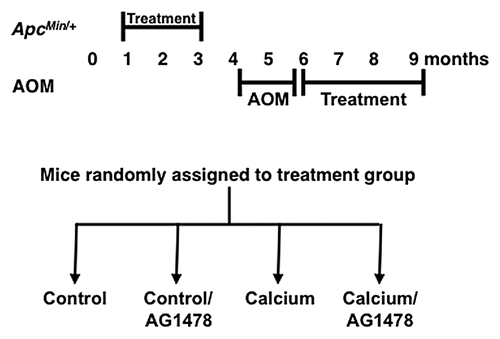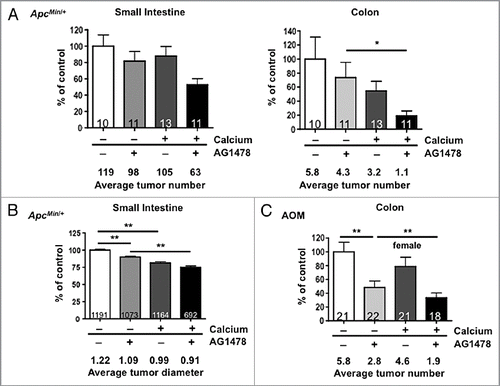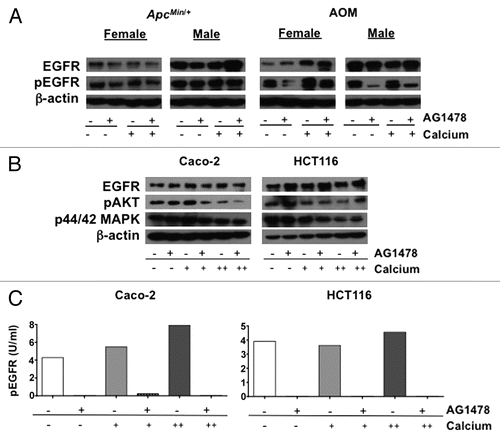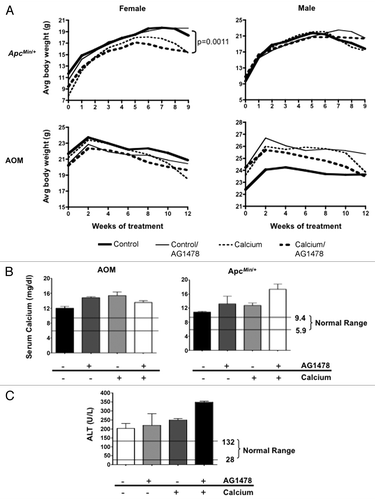Figures & data
Figure 1 Experimental design. At weaning (ApcMin/+) or 1 week following the last carcinogen treatment (AOM) mice were randomly assigned to a control (0.05% calcium) or calcium (5% calcium) supplemented diet, with or without small-molecule EGFR inhibitor AG1478. ApcMin/+ mice were treated for nine weeks and body weight and food consumption was measured at the beginning and end of treatment. AOM mice were treated for four months and body weight and food were monitored biweekly throughout the treatment period.

Figure 2 Effect of calcium on AG1478-mediated tumor (A) number and (B) size in ApcMin/+ and (C) tumor number in AOM models. Values are expressed as a percent of control treatment. Number of mice (A and C) and number of tumors (B) are displayed in bars of graph. Equal numbers of males and females were used and data for both sexes are shown. (C) A significant difference in tumor number is observed in AG1478 compared with Calcium/AG1478 treated mice only in females, but data for both sexes is shown. *p < 0.001; **p < 0.0001. Error bars show SEM.

Figure 3 MTT assays of Caco-2 and HCT116 cell viability treated with AG1478 and/or calcium. (A) Calcium chloride and (B) AG1478 decrease cell viability compared with the control (no treatment) in a dose dependent manner. Supplementing a constant dose of AG1478 with increasing doses of calcium chloride results in reduced cell viability in an additive manner in both (C) Caco-2 and (D) HCT116 cells. Numbers within the bars indicate percent reduction when compared with control untreated cells. Error bars show SD.

Figure 4 Effect on signaling after AG1478 and calcium treatment. (A) In vivo: mice maintained on a control or calcium supplemented diet, with or without AG1478, were injected with phosphatase inhibitor prior to euthanasia. EGFR activation was measured in liver protein lysates from ApcMin/+ and AOM mice, separately for each strain and sex. (B) In vitro: protein was extracted from human CRC cells lines after a 4 h treatment with or without 4 µM (Caco-2) or 8 µM AG1478 (HCT116) with 3.5 mM (“+”) and 4.5 mM (“++”) calcium chloride. (C) pEGFR ELISA was performed using protein extracted from cells lines after 2 h treatment with or without 4 µM (Caco-2) or 8 µM AG1478 (HCT116) with 3.5 mM (“+”) and 4.5 mM (“++”) calcium chloride followed by 20 min treatment with EGF.

Figure 5 General health of mice. (A) Comparison of body weight change for ApcMin/+ and AOM mice maintained on a control (solid lines) or calcium (dashed lines) supplemented diets, with or without AG1478. Blood collected at the end of treatment was used for measurement of (B) serum calcium and (C) alanine aminotransferase (ALT) levels. The normal lower and upper levels are indicated for each test. Error bars show SEM.
